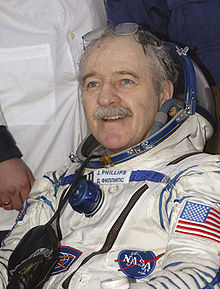John Phillips (astronaut)
| John Phillips | |
|---|---|
 | |
| NASA Astronaut | |
| Statsborger | USA |
| Nationalitet | Amerikaner |
| Status | Aktiv |
| Født | 15. april 1951 Fort Belvoir, Virginia |
Andet arbejde | Naturvidenskab |
| Uddannelses- sted | University of California, Los Angeles United States Naval Academy Scottsdale High School |
| Rang | Kommandør United States Navy Reserve |
Tid i rummet | 203 døgn og 17 timer |
| Udvælgelse | Nasa-gruppen fra 1996 |
| Mission(er) | STS-100, Ekspedition 11, Soyuz TMA-6, STS-119 |
| Missionsemblemer | |
 For alternative betydninger, se John Phillips. (Se også artikler, som begynder med John Phillips)
For alternative betydninger, se John Phillips. (Se også artikler, som begynder med John Phillips)
John Lynch Phillips (født 15. april 1951 i Fort Belvoir, Virginia) er en amerikansk astronaut og videnskabsmand.
Hans første rummission var med rumfærgen på STS-100 i 2001. Senere har han været besætningsmedlem på Den Internationale Rumstation 2005, hvor han opholdt sig i cirka 5 måneder, transporten til og fra rumstationen var med det russiske rumfartøj Sojuz.
John Phillips var, i en alder af 58, missionsspecialist på rumfærgeflyvningen STS-119 til Den Internationale Rumstation marts 2009.
- Medaljer
- NASA Space Flight Medal
- NASA Distinguished Service Medal
- The Gagarin Medal
- The Komarov Diploma
- Og mange flere....
- NASA Distinguished Service Medal
Eksterne henvisninger
- Biografi fra NASA Arkiveret 20. marts 2009 hos Wayback Machine
| Spire Denne artikel om rumfart er en spire som bør udbygges. Du er velkommen til at hjælpe Wikipedia ved at udvide den. |
Medier brugt på denne side
A drawing of NASA's Space Shuttle Challenger. Image provided by Dryden Flight Research Center at Edwards Air Force Base, California. See [1], specifically EG-0076-04.eps.
Logo of Nasa's STS-100 mission.
- The STS-100/6A emblem reflects the complex interaction of robotics and extravehicular activity (EVA) on this mission. During the mission spacewalks will be conducted to deploy the International Space Station Remote Manipulator System (SSRMS). The EVA helmet frames the patch, with the Canadian-built SSRMS shown below the visor. Reflected in the visor is the Space Shuttle Endeavour, with the International Space Station rising above the horizon at orbital sunrise. Endeavour's payload bay houses a Spacelab pallet, itself holding the SSRMS and the Space Station Ultra High Frequency Antenna, and the Italian-built Multi-Purpose Logistics Module "Raffaello." American, Russian, Canadian, and Italian astronauts compose the crew, and their flags are stylized in the lower portion of the emblem. Ten stars adorn the sky, representing the children of the STS-100 crew and the future of space exploration.
The shape of the STS-119/15A patch comes from the shape of a solar array viewed at an angle. The International Space Station (ISS), which is the destination of the mission, is placed accordingly in the center of the patch just below the gold astronaut symbol. The gold solar array of the ISS highlights the main cargo and task of STS-119/15A -- the installation of the S6 truss segment and deployment of S6's solar arrays, the last to be delivered to the ISS. The surnames of the crew members are denoted on the outer band of the patch. The 17 white stars on the patch represent, in the crew's words, "the enormous sacrifice the crews of Apollo 1, Challenger, and Columbia have given to our space program." The U.S. flag flowing into the space shuttle signifies the support the people of the United States have given our space program over the years, along with pride the U.S. astronauts have in representing the United States on this mission.
ISS Expedition 11 insignia.
The emblem of the eleventh expedition to the International Space Station (ISS) emphasizes the roles of the United States and the Russian Federation in the multinational ISS partnership. The two rocket plumes, in the style of the flags of these two nations, represent the Russian Soyuz vehicles and the American Space Shuttles. The ISS image shows the configuration of the orbiting Station at the start of the expedition, with docked Soyuz and Progress vehicles and the huge American solar panels. The names of the two crew members are shown on the margin of the patch. ISS Commander Sergei Krikalev and John Phillips, NASA ISS science officer and flight engineer, are expected to launch on a Soyuz vehicle and to be in orbit during the return to flight of the Space Shuttle. The crew explains, “The beauty of our home planet and the vivid contrasts of the space environment are shown by the blue and green Earth with the Space Station orbiting overhead, and by the bright stars, dark sky, and dazzling sun.”




